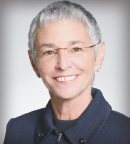Although the United States spends billions of dollars each year on cancer research, very little of that funding is dedicated to mental health research in patients with cancer, despite the fact that cancer survivors have a six-time higher risk for psychological disability than people without cancer.1 And the incidence of psychological disorders, including depression and anxiety, in survivors is very high, between 30% and 60%, but it is estimated that fewer than 10% of patients are referred for psychological help.2 Even when patients receive referrals for mental health services, many do not seek care because either they do not understand what that care will involve or they believe their insurance will not cover the cost of the services, according to Paul B. Jacobsen, PhD, FASCO, Associate Director of the Healthcare Delivery Research Program at the National Cancer Institute.

Paul B. Jacobsen, PhD, FASCO
Other social and clinical barriers to the management of depression and anxiety among people with cancer include lack of physician time for assessing patients’ symptoms and normalization of distress and attribution of the somatic symptoms of depression and anxiety to the cancer and its treatment. Patients may also be reluctant to disclose psychiatric symptoms for fear of the stigma surrounding mental health conditions. However, the consequences of not addressing the psychological needs of patients with cancer can be catastrophic, including reduced quality of life, increased adverse effects from treatment, and even an impact on survival.3
In 2014, ASCO published a screening, assessment, and treatment adaptation guideline for anxiety and depression symptoms in adults with cancer.4 The guideline recommends the following:
- Screening all patients for depressive symptoms at their initial visit, at appropriate intervals, and as clinically indicated, especially with changes in disease and treatment status and transition to palliative and end-of-life care
- Screening using a valid and reliable measure that features reportable scores that are clinically meaningful
- Immediate referral to a psychiatrist, psychologist, physician, or equivalently trained professional for specific concerns, such as the risk of patient self-harm or harm to others, severe depression or agitation, or the presence of psychosis or confusion
- Offering support and providing education and information about depression and its management to all patients and their family members, including what specific symptoms and what degree of symptom worsening warrants a call to a physician or nurse
- Assessing patients’ pharmacologic treatment, their concerns about adverse effects, and satisfaction with the symptom relief provided by the treatment.
This past fall, Dr. Jacobsen led a panel discussion at the Supportive Care in Oncology Symposium on “Psychological Issues: Where Are We Now and Where We Need to Go,” in which he outlined the need for research on how to implement these and similar guidelines as part of routine clinical practice, especially in community oncology settings. The ASCO Post talked with Dr. Jacobsen about the risk factors for developing depression or anxiety in patients with cancer; screening models to assess patients’ level of distress; and helping long-term survivors of metastatic cancer live less fearful and high-quality lives.
Understanding the Predictors of Depression or Anxiety Onset
What are the risk factors for psychosocial distress after a cancer diagnosis? Are certain individuals more prone to feelings of depression and anxiety after a cancer diagnosis? Do specific types of cancer increase the likelihood of depression or anxiety in patients?
One of the best predictors of whether a patient will experience depression or anxiety after a cancer diagnosis is the patient’s history of mental health issues, because the diagnosis and treatment of cancer may reactivate a preexisting mental health condition. That said, some people experience a first episode of anxiety or depression after a cancer diagnosis. A lot of what determines how a person reacts to a cancer diagnosis depends on the person’s individual circumstances, including how difficult the treatment is and the amount of social support the patient has.
Cancers that are diagnosed at a later stage, when cure is unlikely, or that have a poor prognosis even at an earlier stage also may contribute to depression and anxiety in patients. Finally, some cancers may have a biologic component in which the cancer itself contributes to the incidence of depression. For example, I have often seen depression in patients diagnosed with pancreatic cancer, which might be part of the underlying cancer syndrome. Depression is also common in patients with lung cancer, especially smokers. Studies show that smokers have higher rates of depression than nonsmokers, which may also increase their risk of depression after a lung cancer diagnosis.
GUEST EDITOR

Jamie H. Von Roenn, MD, FASCO
Diagnosing Psychosocial Conditions
Please talk about screening mechanisms oncologists can use to determine which patients are likely to experience episodes of depression or anxiety.
There are several very good screening tools for identifying depression in patients, including the Patient Health Questionnaire-9.5 For anxiety, there is the General Anxiety Disorder-7 (GAD-7), which screens for many common anxiety disorders.6
To save time during a clinic visit, physicians can make these screening tool questionnaires available for patients to fill out on a patient portal or a tablet prior to coming into the clinic.
Devising New Models for Delivering Psychosocial Care
During your presentation at the Supportive Care in Oncology Symposium, you talked about the need to expand the scope of mental health research to generate “real-world” evidence to drive positive changes in public policy and practice for psychosocial care in patients with cancer. What type of evidence is needed to improve this psychosocial care?
In addition to developing new therapies for depression and anxiety disorders, we need to implement existing effective models for delivering psychosocial care, for example, the collaborative care model for the treatment of depression. This approach to psychosocial care involves the integration of myriad health-care providers, including care managers and consultant psychiatrists, with primary care or oncology physician oversight to manage mental health disorders.
This model of care is highly applicable in the community oncology setting, in which access to a staff mental health provider may be low, but where patients can still receive assessment and treatment for depression or anxiety through psychiatry consultants working with members of the clinical care team. This model of care may have seemed improbable before the COVID-19 pandemic, but the increase in telehealth services makes it easier for community practices to arrange for psychiatric assessments of their patients and for patients to talk directly with a mental health professional who may not be located in the clinic.
I hope we will see the recently loosened regulations for coverage of telehealth services at the federal and state levels become permanent.
“One of the best predictors of whether a patient will experience depression or anxiety after a cancer diagnosis is the patient’s history of mental health issues.”— Paul B. Jacobsen, PhD, FASCO
Tweet this quote
Long-Term Consequences of Living With Metastatic Cancer
There are about 17 million cancer survivors in the United States,7 and cancer is now often managed as a chronic disease. Please talk about the psychosocial ramifications of living with cancer as a chronic disease in which there are ongoing treatment side effects, financial toxicity, and concerns about cancer progression.
We now have a relatively new category of cancer survivors that some have referred to as “metavivors.” This group includes individuals who are living for many years with a diagnosis of advanced or metastatic disease, due in large part to the introduction of new cancer therapies. We need a lot more information about how well they are coping, what their concerns are, to what extent they are experiencing high levels of fear of disease progression, and how we can provide effective support for these individuals.
At the National Cancer Institute, we have begun to gather information about the scientific gaps and research opportunities that exist for understanding and addressing the major quality of life and health-care delivery issues in this growing population of cancer survivors. Once we assemble that information, we plan to share it with the investigator community and encourage research to improve the lives of people living for extended periods with advanced and metastatic disease.
DISCLOSURE: Dr. Jacobsen reported no conflicts of interest.
REFERENCES
1. Martinez MR, Pasha A: Prioritizing mental health research in cancer patients and survivors. AMA J Ethics 19:486-492, 2017.
2. Anuk D, Özkan M, Kizir A, et al: The characteristics and risk factors for common psychiatric disorders in patients with cancer seeking help for mental health. BMC Psychiatry 19:269, 2019.
3. Niedzwiedz CL, Knifton L, Robb KA, et al: Depression and anxiety among people living with and beyond cancer: A growing clinical and research priority. BMC Cancer 19:943, 2019.
4. Andersen BL, DeRubeis RJ, Berman BS, et al: Screening, assessment, and care of anxiety and depressive symptoms in adults with cancer: An American Society of Clinical Oncology guideline adaptation. J Clin Oncol 32:1605-1619, 2014.
5. New York State Department of Health: Administering the Patient Health Questionnaires 2 and 9 (PHQ 2 and 9) in Integrated Care Settings. Available at https://www.health.ny.gov/health_care/medicaid/redesign/dsrip/2016-07-01_phq_2_and_9_clean.htm. Accessed July 22, 2020.
6. Anxiety and Depression Association of America: GAD-7 Anxiety. Available at https://adaa.org/sites/default/files/GAD-7_Anxiety-updated_0.pdf. Accessed July 22, 2020.
7. National Cancer Institute Division of Cancer Control & Population Sciences: Statistics, Graphs and Definitions. Available at https://cancercontrol.cancer.gov/ocs/statistics/index.html. Accessed July 20, 2020.

